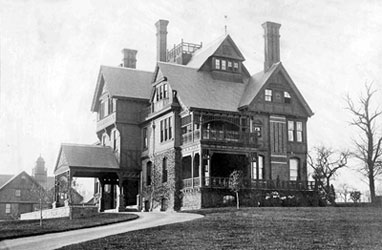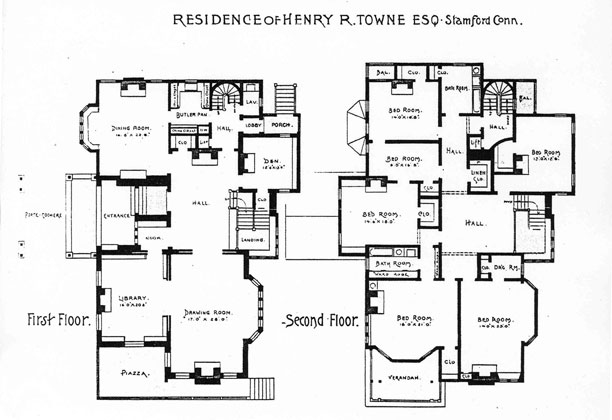The Stamford Historical Society Presents
GRACIOUS LIVING IN STAMFORD
Late 19th and Early 20th Centuries
Photos and Objects from Our Collection
Atlantic Street
Residence of Jas H. Hoyt on Atlantic Street, c. 1860
The home stood opposite Central Park.
Residence of Walton Ferguson on Atlantic Street,
c. 1882
Built by Captain Kiddy in 1858. Architect: A Mr. Marsden.
The house became Ms. Low's School for Girls in 1907.
The Main Post Office now stands on the site.
 “Rockland,” Henry R. Towne Home, c. 1892, Corner Atlantic and Henry Streets
“Rockland,” Henry R. Towne Home, c. 1892, Corner Atlantic and Henry Streets
Built in 1875, the house became later the Rockland Hotel.
Henry R. Towne (1844-1924) was an engineer and manufacturer, and the founder, with Linus Yale, of the Stamford Yale Lock Company. He was also the pioneer builder of cranes in the United States.
From Made in Stamford by Gregg D. Mecca, Stamford Historical Society 1984:
The advantages of Stamford's water and rail links attracted the attention of Linus Yale, Jr., and Henry R. Towne, who had begun a partnership in the manufacture of locks in Shelbourne, Massachusetts. Linus Yale was an inventor and manufacturer of bank locks eager to expand his small business when Henry R. Towne, an engineer, met him, took an interest in his work, and saw in it the opportunity for the development of an important new industry. The success of the Yale Lock Company, as the partners' firm was originally called, was based on the cylinder or five-pin tumbler lock patented by Linus Yale in 1861. It was compact, offered many combination variations, was virtually pick-proof, and had a lightweight key.
In 1868 Towne and Yale decided to move their business to Stamford, choosing a site between the canal and the railroad along Pacific and Market streets in the South End. Although Linus Yale died suddenly on Christmas Day 1868, Towne pressed ahead with construction of the factory and opened in May 1869. Towne acquired sole ownership of the company, and in 1883 renamed it the Yale & Towne Manufacturing Company. He acted as company president until 1915 and chairman of the board until his death in 1924. Gifted with exceptional organizational skills, Towne instituted a modern factory system to replace what had formerly been done by hand.
Yale & Towne produced some of the most outstanding hardware in the country and made notable advances in the design of post office boxes and locks and blocks and pulleys. The success of the Yale & Towne Company was so complete that the company rapidly expanded its physical plant and work force. In the company's first three years of operation the number of workers rose from 30 to 150. By 1892 the company occupied 21 acres in the South End (the complex eventually topped off at 25 acres) and employed nearly 1,000 people out of a total population of nearly 16,000 or one in every 16 Stamford residents. In 1907 that number had risen to 3,000 and by 1916 it had reached 5,000.
The city's largest single employer and manufacturing firm, Yale & Towne dominated Stamford's economy within 25 years of its establishment and continued to do so until it departed in the 1950s. The predominance of the firm is reflected in the nickname "The Lock City" chosen by the city in the early 1900s. The seal of the City of Stamford also bears a depiction of two Yale & Towne keys.

Floor Plan, July 1890
October 16, 1924 Obituary of Henry Towne

